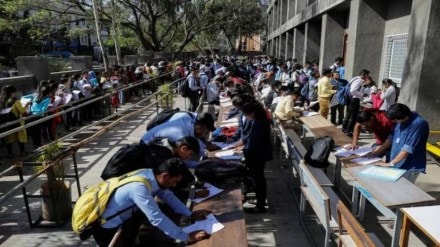By Surya Sarathi Ray
Empirical evidence shows freshers found it challenging to enter the job market. Even as the situation is grim now, the trend seems to be reversing. Around 58% of 10.14 lakh new subscribers who joined social security schemes run by the Employees Provident Fund Organisation (EPFO) in June 2023 were from the 18-25 age group, considered freshers or first-timers in the job market. The freshers’ share in the newly registered members with the Employees’ State Insurance Corporation (ESIC) for the same month was 49%.
An official statement issued late last month said active job vacancies registered on the Labour Ministry’s National Carrer Service (NCS) portal, which brings job seekers and employers on one platform, crossed the one-million mark for the first time, indicating rising employment opportunities. Also, one-third of the jobs notified by the public and private sectors are for freshers.
What do numbers show?
In June, the number of new subscribers joining the EPFO was the highest since August last year. While new subscribers’ addition to the EPFO fold indicates formalisation of jobs – if not all new jobs – is on the rise, the freshers’ share in the new enrollments in June was higher than the previous two months of the current fiscal year and the average monthly addition of the last five financial years. EPF applies to establishments having 20 or more workers.
Ditto for ESIC. A little over 49% of 15 lakh newly registered members in the social
security schemes run by the ESIC in June were freshers. The share is higher than the previous two months of the current fiscal and the monthly average of the last five financial years. ESIC is applicable in units having ten or more people. The freshers’ demand in the job market, as shown in the NCS portal, also signifies that young candidates are getting job opportunities right after their education.
Types of jobs on offer
The quality of the jobs could be better, however. The August 28 statement of the Labour Ministry said, “A significant number of vacancies registered on NCS are related to the job roles of technical support executives, sales executives, data entry operators, logistics executives, software engineers, maintenance engineers, etc. The vacancies on NCS span diverse sectors, indicating a boost in employment opportunities across the country. 51% of the active vacancies have been reported in finance and insurance, and 13% in the transport and storage sector. Other sectors like operations & support, IT & Communication, manufacturing, etc. contributed approximately 12% of the vacancies and registered a surge in vacancies during June-August, 2023.”
EPFO’s June data also showed a similar trend. A little over 40% of the net addition during the month was from expert services consisting of manpower suppliers, normal contractors, security services, miscellaneous activities, etc. Others work in trading-commercial establishments, building & construction industry, electrical, mechanical and general engineering products, followed by textiles, financing establishments, schools, hospitals, etc. The ESI Scheme applies to factories and other establishments such as road transport, hotels, restaurants, cinemas, newspapers, shops, and educational institutions wherein ten or more persons are employed.
Is the unemployment rate on the wane?
Private sector think-tank Centre for Monitoring Indian Economy (CMIE) data showed that the country’s overall joblessness rate in July this year fell to 7.95% from 8.45% in June, mainly driven by a surge in demand for agricultural labour in rural areas. The annual Periodic Labour Force Survey (PLFS), conducted by the Ministry of Statistics and Programme Implementation (MoSPI), found that the unemployment rate has been on the wane for both urban and rural areas to stand at 4.1% in 2021-22 compared with 4.2% in 2020-21 and 4.8% in 2019-20 for persons of 15 years and above on usual status.
However, all’s not well
The Worker Population Ratio (WPR), the percentage of employed persons in the population for persons of 15 years and above, rose marginally from 50.9% in 2019-20 and 52.6% in 2020-21 to 52.9% in 2021-22 on the usual status, determined based on a one-year reference period preceding to the survey.
While employment growth has failed to keep pace with economic growth, the labour Force Participation Rate (LFPR) is the percentage of persons in the labour force either employed or seeking work, has to move up from 55.2% in 2021-22 and 54.9% in 2020-21 for persons of 15 years and above. There is a substantial gender-wise disparity in the job market as well. A recent study found that just about 53% of Indian graduates are employable for non-technical jobs and 44% for technical jobs, highlighting the massive disconnect between academia and corporates. Also, the lion’s share of India’s workforce belongs to the informal sector, sans any social security benefits like EPF or ESI. A large chunk of the job now is in the gig economy, where no employee-employer relationship exists and, thus, no social security net. Their numbers are increasing. The government has plans to bring a vast chunk of this vulnerable workforce, including the gig workers, under some social security net, but that is some months, if not years, away. (ends)
Share of 18-25 age bracket in fresh enrollment under EPFO and ESIC:
| EPFO | % | ESIC | % |
| FY19 | 51 | FY19 | 48 |
| FY20 | 53 | FY20 | 49 |
| FY21 | 51 | Fy21 | 48 |
| FY22 | 55 | FY22 | 48 |
| FY23 | 56 | FY23 | 48 |
| April FY24 | 53 | April FY24 | 47 |
| May FY24 | 56 | May FY24 | 47 |
| June Fy24 | 58 | June Fy24 | 49 |
The author is a freelance senior journalist.
Disclaimer: Views expressed are personal and do not reflect the official position or policy of Financial Express Online. Reproducing this content without permission is prohibited.
